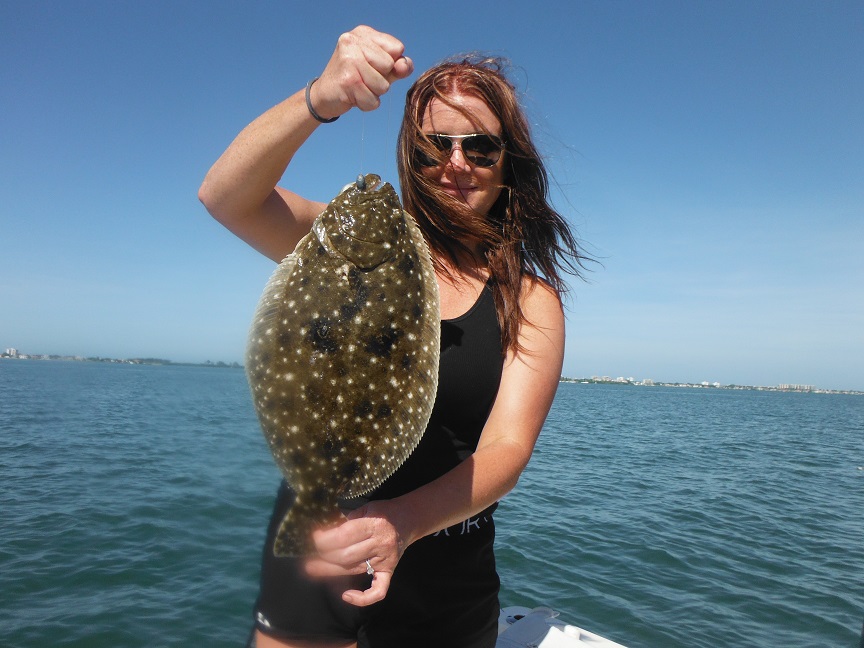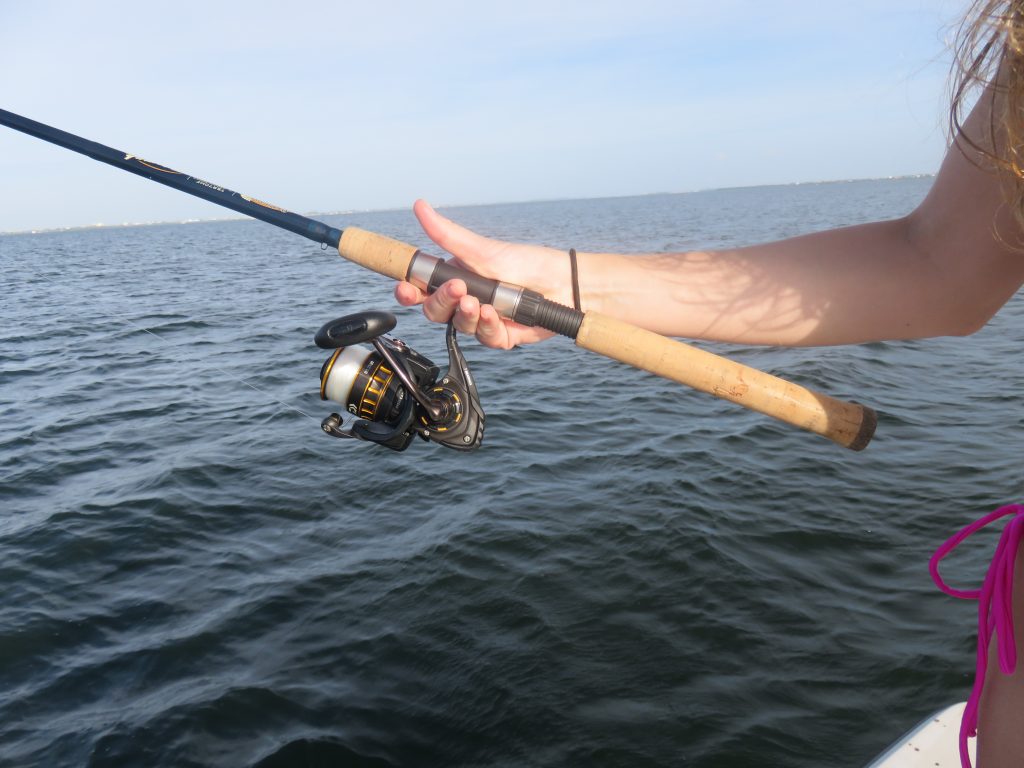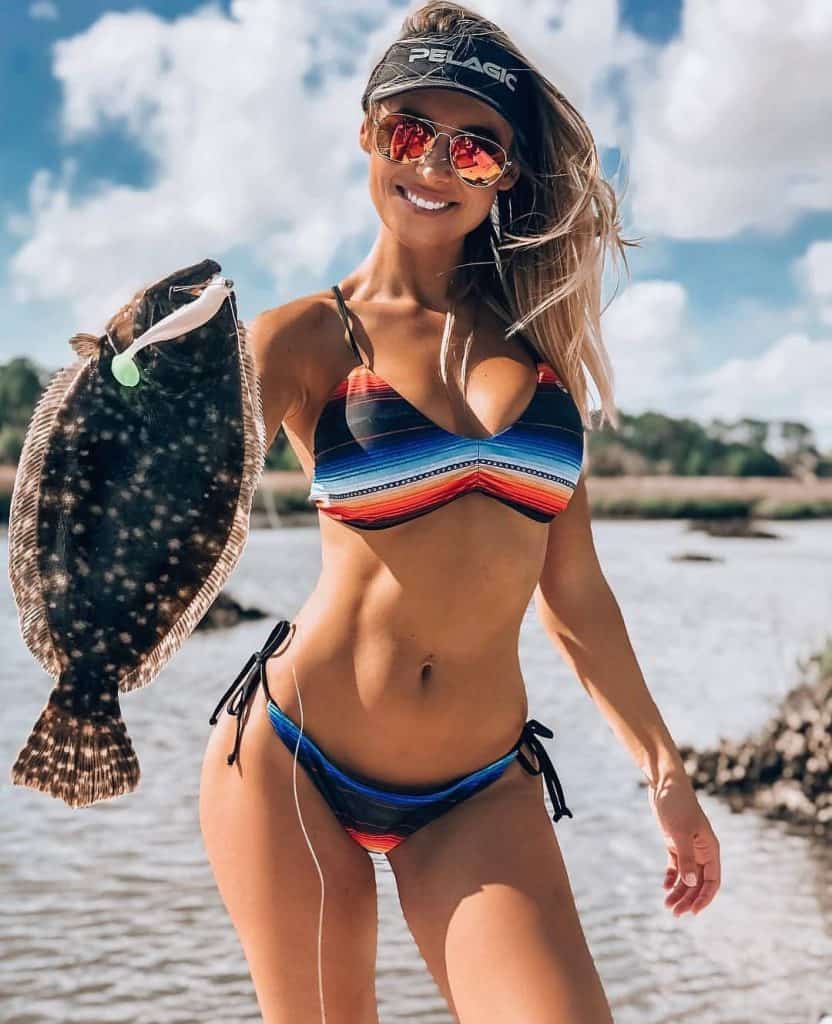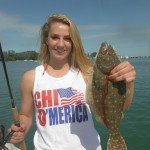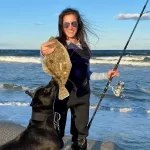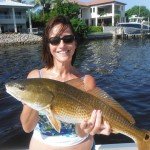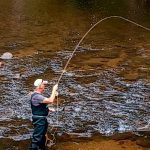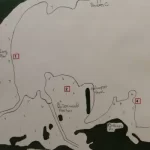Flounder fishing in Florida, an angler’s guide
Flounder are a very popular inshore game fish. Anglers flounder fishing in Florida enjoy both the battle and some delicious fillets! While some flounder are caught while fishing for other species, those targeting flounder in Florida will have success by adapting their techniques to the habits of these unusual game fish species.
Flounder are the perfect bottom dwelling ambush predator and are a popular saltwater game fish in Florida. They are the most numerous species in the flatfish family. Flounder lie on their sides in the sand, often times buried with only their eyes looking up. Any bait fish, shrimp, or other prey that comes within range can be instantly devoured. North Florida in particular offers anglers excellent flounder fishing.
Most anglers flounder fishing in Florida will catch the southern Gulf flounder. These are easily identified by the three black spots on the back in a triangular shape. Southern golf flounder are similar to flounder found throughout the world, they just prefer the warmer waters of the Gulf of Mexico and southern Atlantic Ocean.
Top Florida flounder fishing spots
While southern Gulf flounder are found throughout the entire state of Florida, the northern half of the state does seem to offer better flounder fishing. This is largely due to cooler water which the flounder prefer along with ideal conditions. Tidal creeks and rivers in North Florida are ideal flounder habitat. Tides are also much stronger, increasing the advantage that flounder have over hapless bait fish and crustaceans.
Top 19 Florida flounder fishing spots;
-
Fernandina Beach
-
St Johns River in Jacksonville
-
Pensacola and Escambia Bay Pensacola
-
St Augustine rivers and inlet
-
Indian and Banana Rivers at Cape Canaveral
-
Choctawatchee Bay
-
Ft Pierce Inlet
-
Panama Bay
-
Apalachicola Bay
-
Saint George Sound
-
Apalachee Bay
-
Steinhatchee
-
Stuart
-
Cedar Key
-
Crystal River and Homasassa
-
Jupiter Inlet
-
Tampa Bay
-
Charlotte Harbor
-
Everglades National Park
Flounder have an interesting life. They are born like most fish and swim vertically with an eye on each side of their body. As they mature, flounder start swimming on their side and the eye that was on the bottom migrates around so that both eyes are now on the top of the fish. It then spends the rest of its life swimming on its side, with both eyes looking up. These are “left sided” flounder, with both eyes on the left side.
Florida flounder habits
While flounder do prefer to bury themselves in the sand and lie in ambush, they are also structure oriented. This sounds like a bit of a contradiction, but it really isn’t. Typical structure that Florida anglers fish on a daily basis will hold flounder. These include bridges, rock jetties, docks, oyster bars, rocky ledges, and artificial reefs. The only difference is that flounder will often stage right on the outside edge of these structures were sand is available. Normally, the up-tide side of the structure is best.
Check out this article on inshore saltwater fishing in Florida
Flounder are opportunistic leaders. They prefer live forage including bait fish and crustaceans such as crabs and shrimp. The most effective baits are live minnows and shrimp along with artificial lures that mimic this forage.
Flounder fishing tackle and rigs
Anglers flounder fishing in Florida did not purchase any special tackle. The same light to medium action spinning tackle and light bait casting tackle that is used for other forms of inshore fishing will work fine. A 7 foot medium action spinning rod paired with a 3000-4000 series reel is a fine all round combination. Light conventional tackle is a great choice when drifting and strong currents or went fishing around heavy structure.
Anglers can shop at Amazon for a Daiwa Black Gold reel and St Croix Triumph 7′ MF rod spinning combo in this link.
“Fishing Lido Key is a participant in the Amazon Associates Program, an affiliate advertising program designed to provide a means for sites to earn advertising fees by advertising and linking to Amazon. As an Amazon Associate I earn from qualifying purchases.”
Many anglers choose to use braided line due to its sensitivity and zero stretch qualities. However, monofilament line is fine as well, it really just is a personal choice. With both lines, a leader is required. A 2 foot long piece of 30 pound fluorocarbon leader is a good all-around choice. The leader can be attached using a knot such as a blood knot or double Uni Knot or by simply using a number 10 black swivel. The hook or lure can then be attached to the end of the leader.
Flounder fishing rigs
Anglers flounder fishing in Florida will do well with a couple simple rigs. Flounder fishing does not need to be complicated. Flounder are caught in Florida by anglers using both live bait and artificial lures. The number one artificial lure by far is a jig as it can be worked on or close to the bottom where flounder feed.
Split shot rig
The simplest flounder fishing rig is the basic split shot rig. A # 1/0 live bait hook or a # 3/0 circle hook is tied onto the end of the leader. Split shot is used to get the bait down to the bottom. Obviously, this rig is best used in shallow water or in mid depths with very little current. The required weight can be easily adjusted as it is a simple matter to add or remove split shot as required.
Knocker rig
The knocker rig is a very effective rig for anglers flounder fishing in Florida. A sliding egg sinker is threaded onto the end of the leader. The hook is then tied on. The sinker will slide down and ride right on top of the eye of the hook. This looks a lot like what bass anglers call “Texas rigging” when fishing with plastic worms.
This rig has several advantages. If the hook snags, the sliding weight can help dislodge the hook, knocking it off of the snag. This is how the rig gets its name. It is very quick and easy to tie into chains weight. Finally, with this rig anglers can be sure that when the weight is on the bottom the bait will be as well.
Sliding sinker/Carolina rig
The sliding sinker rig, also known as a Carolina rig, is a very popular and versatile all round bottom fishing rig. With this rig, the sinker is threaded on ahead of the swivel. The leader is then tied onto the other end of the swivel, followed by the hook. Anglers often times make this leader a bit longer than normal, up to 4 feet long.
The beauty of this rig is that when a fish picks up the bait, it will not feel the resistance of the weight. Also, with the longer the leader the bait tends to flutter up and move around, making it more naturally appearing. Anglers will even sometimes at a small float a foot above the hook to lift the bait up.
Spreader rig or High/low rig
The spreader rig, also known as a high/low rig is most often used when fishing for other bottom fish. However, it can be effective for flounder as well. This is especially true when flounder are active and feeding a tad off the bottom.
3 Way rig
The 3 way rig is an excellent choice for anglers drift fishing for flounder. It consists of a three-way swivel which is tied to the terminal line. A short dropper is added to the second ring of the swivel which then has the weight tied on. Anglers fishing in areas with a lot of snags often use lighter line so that if the weight does snag the rest of the rig can be saved. A 2 foot to 4 foot leader followed by the hook is tied onto the third ring of the swivel.
Flounder fishing in Florida with artificial lures
While most anglers associate flounder with live or cut bait, many a Florida flounder has fallen victim to a well presented jig. Jigs are by far the most effective artificial lure for anglers flounder fishing in Florida. The reason is quite simple; the jig can be worked right on or near the bottom, which is the strike zone in which flounder feed.
Both buck tail jigs and soft plastic grub’s on a jig head are extremely effective on flounder, and just about every other inshore saltwater species. In fact, many flounder are caught by anglers pursuing redfish, speckled trout, and other species on the flats. A white buck tail jig is incredibly effective, particularly when -tipped with a small strip of cut bait or a small piece of fresh shrimp.
Soft plastic grubs on a jig head are very effective as well. A 3 inch to 4 inch shad tail or a shrimp tail bait on a 1/4 ounce jig head is an excellent all round flounder fishing lure. Scented soft plastic baits such as the Gulp line of baits work very well, especially when the bite is a little tough.
Flounder fishing techniques in Florida
Many anglers catch flounder while fishing for other species. However anglers who specifically fish for flounder do change their tactics just a bit. The key difference is understanding how flounder relate to structure and cover. Like most fish species, flounder will generally stage on the up tide side of cover or structure.
As stated earlier, they will generally be in that transition zone where the structure changes from a rocky bottom to a sandy one. This is true on the open grass flats as well. Flounder will most often be found in Sandy potholes as well as on bars where the grass transitions to a sandy bottom.
Bottom fishing for flounder with live and cut bait
Most flounder are landed by anglers fishing with either live or cut bait on the bottom. This is fairly simple fishing, yet very effective. Anglers working a specific piece of structure most often anchor. The best technique is to anchor up current of the structure to be fished. This allows the bait to be floated back naturally to where the fish should be holding.
As with all bottom fishing, the best approach is to use the minimum amount of weight required to reach bottom. If the bait actually moves or drifts a little bit with the current, so much the better. This just results in a more natural presentation. However, anglers do need to be wary of hanging up if the bait drifts too much. Surf fishing for flounder can be productive as well.
The amount of weight required can vary from just a couple of split shot for anglers fishing a dock in shallow water with little current to several ounces when fishing a bridge or other deep structure in swift tides. The sliding sinker rig and knocker rig are good choices when bottom fishing for flounder in deeper water.
Anglers can also choose to drift fish for flounder. This is an extremely effective method when flounder are scattered over a large area. Generally speaking, the best areas for this type of flounder fishing are sandy flats between 5 feet deep up to 20 feet deep. Patches of grass or hard bottom will increase the odds of success. The three-way rig works best as it offers a natural presentation it allows anglers to quickly and easily change weights to match the conditions.
Flounder fishing lures; jigs are best
Flounder fishing with artificial lures is actually fairly similar to those using live or cut baits. Most anglers pursuing flounder with lures do so while drifting as opposed to anchoring. This allows them to cover a lot of water in a relatively short amount of time. Anglers drifting deeper flats or working structure such as bridges will do well vertically fishing, bouncing the jig off the bottom as the boat drifts along.
Those flounder fishing in Florida in shallower waters will do well by casting their jigs out. Anglers can use a trolling motor to work a row of docks or a shoreline while casting the jig out to likely fish holding spots. Jigs are also effective when cast out in front of the drifting boat on the open grass flats. Depressions, pot holes, and edges of bars are prime spots.
Top flounder fishing baits
Flounder are opportunistic feeders and can be taken on a variety of natural forage. Small bait fish or minnows are top choices. These can include finger mullet, but minnows, threadfin herring, scaled sardines, as well as small pin fish and grunts. In many cases, anglers will have to catch their own live bait fish, though there are some shops that sell them.
Live shrimp are a top natural bait for flounder and just about every other saltwater species. One benefit to live shrimp is that they are available year-round at just about every bait and tackle shop. Anglers fishing with live shrimp will have to be prepared for the myriad of other species that will intercept a shrimp meant for a flounder. However, this is not a terrible problem to have!
Cut bait can be extremely effective when flounder fishing as well, particularly off the surf and in deeper areas with a bit of current. A strip of cut bait will move seductively in the current while also emitting sent which will attract the flounder. Just about any legal fish can be cut up and used as bait. The white belly sections are often best. Frozen squid is a top flounder bait and is readily available. The best approach is to use a strip of bait 3 inches to 5 inches long and and inch or so wide that tapers to a point.
Best spots when flounder fishing in Florida
While southern Gulf flounder are found throughout the entire state of Florida, the northern half of the state does seem to offer better flounder fishing. This is largely due to cooler water which the flounder prefer along with ideal conditions. Title creeks and rivers in Northeast Florida are ideal flounder habitat. Expansive shallow water flats in both the Gulf of Mexico and inshore bays provide the perfect place for flounder to flourish.
Tidal creeks
Tidal creeks are outstanding spots to search for flounder and other species. Northeast Florida is well-known for these types of creeks and rivers. Tides are extreme in this area! However, title creeks can produce flounder throughout the state and all year long, with the exception of very warm periods.
The best time to fish for flounder in title creeks is on a high, outgoing tide. On the high tide, flounder and other game fish will move up on the flats to feed. As the tide turns to go out, fish will stage at the mouse of feeder creeks and drains and ambush prey as it washes out with the current.
Both live bait and jigs work well in this situation. Most anglers drift with the current in search of fish. Once a decent concentration of flounder is located, anglers can anchor and work the area thoroughly. It is important to be careful on these outgoing tides so that the boat is not left high and dry. Extreme tides in Northeast Florida can vary as much as 10 feet in a six-hour.
Docks
There are untold numbers of docks in the state of Florida. Docks can be found in backwater canals, passes and inlets, and on flats. Anglers can choose to anchor up current of a dock and pitch live or cut baits back to it. Another effective approach is to cast jigs or live baits while working a row of docks with the trolling motor. This method will help anglers eliminate unproductive water more quickly.
Bridges
Bridges are flounder magnets! They generally have all of the ingredients required to hold fish. Often times, the water is deeper and the tides are swifter and areas were bridges are built. Abundant structure from the pilings and reinforcing rubble below offers perfect fish holding habitat.
Anglers can drift bridges while working jigs or natural baits on or near the bottom. Many anglers also prefer to anchor up current of bridge pilings and float natural baits back with the current. Both of these methods can be quite effective. Those who decide to anchor need to make sure that they are doing so legally, staying out of the main channel and knot tying up to the bridge pilings themselves.
Inlets and passes
Many flounder are caught by anglers fishing inlets and passes. Pass is just another term for an inlet that is used on the Gulf Coast of Florida. Inlets are natural fish highways that connect the open waters of the golf and the ocean with the in land bays. They are natural spots for flounder to congregate and feed.
Many inlets have rock jetties extending along the mouth of the inlet. While anglers fishing these areas will inevitably snag quite often, it is often worth the effort as these are prime fish holding locations. Fishing at periods of low current such as the turn of the tide will help reduce snags. Docks and bridges are often found in inlets and passes as well. Anglers can also drift the open pass or inlet. However, this is discouraged during periods of heavy boat traffic. Also, anglers should never try to anchor in an inlet or pass when strong currents or heavy boat traffic is present!
Flats
Many a flounder has been caught by anglers fishing the flats in Florida. Oyster bars are prime spots to catch a flounder, particularly where they drop off into slightly deeper water. Depressions in grass flats can hold flounder as well. Sand bars that drop off into grass in deeper water are prime spots, particularly on a high outgoing tide.
Anglers can do well catching flounder using live bait on the flats. However, this is a situation that is made for artificial lures. Anglers casting jigs can cover a lot of water and thoroughly work the prime spots. The best approach when using live bait is to free line a live shrimp or bait fish using a small split shot if required.
Flounder for dinner!
While flounder are fun to catch, they are prized just as much or more for their value on the dinner plate. Flounder are considered one of the best eating fish on the planet. They are a very mild fish with white flesh and are quite delicate. Most recipes go light on the spices and breading in order for the taste of the flounder to come through. Flounder can be baked, broiled, or fried. They are not the greatest candidate for grilling due to their delicate nature.
However, flounder are a bit difficult to clean. This is due to their unusual shape. The best approach when cleaning a flounder is to lay it down and make the first cut right along the backbone that goes down the center of the fish. The fillet knife is then worked along the bones from the inside working out towards the edges of the fish. Many anglers make the mistake of discarding the flounder after removing the top fillets. This is a mistake as the underside, or white side, of the flounder has plenty of meat as well. Anglers can find current Florida flounder fishing regulations on the FWC site.
In conclusion, this article on flounder fishing in Florida will help anglers catch more of these hard fighting an incredibly tasty bottom dwellers!
